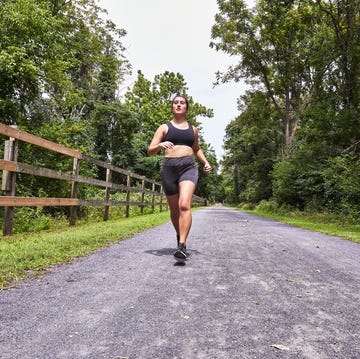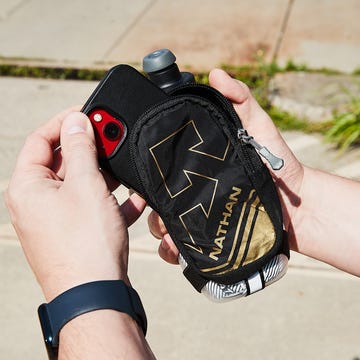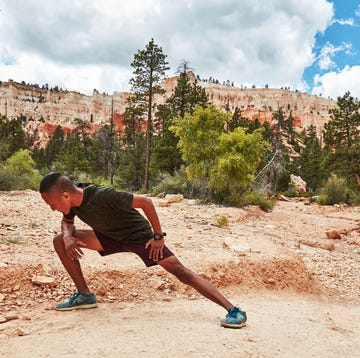Training for a race comes with many moving parts, both figuratively and literally. You have to maintain a healthy diet, build mental toughness, and of course, run. When it comes to running, you can prepare to flow through different phases: the base, build, peak, and taper. Navigating these phases, however, can be a little challenging and complicated, especially if you lack the guidance of a coach or experienced running buddy.
Assuming you’ve built up a solid base, a training plan typically starts with the build phase and works up to a peak and taper before race day. During the build phase, you want to focus on improving your performance and strength so you can do your best on race day, whether that means crushing a goal time or simply finishing.
Here, we explain how to approach the build phase in order to get the most out of it, no matter what distance you’re training to run.
What is the build phase of running?
As mentioned, your training plan will start off with the build phase, which can last anywhere from three to nine weeks before you peak and taper off until race day. During this time, you should focus on slowly increasing the intensity of your runs, says Laura Filla, level 2 RRCA-certified running coach, certified personal trainer, and the owner of Filla Endurance.
In comparison to the base phase where you can expect to run slow and easy, the build phase is when you start to pick up the pace. “Here we really start working on performance,” says Jason Fitzgerald, USATF-certified running coach, Strength Running head coach, and host of the Strength Running podcast. “This is where we actually start caring a lot more about your workout splits.” It’s also when your workouts will start to incorporate your goal race pace, he adds.
Working with a trusted and certified run coach can help you get the most out of this particular phase, but if you don’t have a coach, here are a few things you can do to make sure you’re maximizing this stage of training.
How to Make the Most Out of Your Build Phase
Do a Time Trial
After you complete your base training plan, you can test your speed with a three-mile time trial, says Filla. This will help you define your fitness level and certain training paces before you start your next phase. She recommends completing this trial on a flat route, so you can run your fastest with quick leg turnover.
If you’re a beginner, jumping into a short-distance race right at the beginning of a build phase can help you achieve the same results as a time trial, says Fitzgerald. “The shorter, the better,” he says. “A mile, two miles, or a 5K just to establish some baseline tests of ability, and then you can base training paces off of those early races.”
Balance Intensity With Recovery
The base phase is all about improving consistency and volume so you can kick up the intensity of your runs when it comes time for the build. But during that base phase, you should introduce small sets of speedwork so you can build on it, like strides or 30-second hill repeats, says Fitzgerald.
Once you start the build phase, intensity becomes more important, and you’ll slowly build on it, just like you do mileage.
“With the build phase, now we’re transitioning into a little bit more quality work, and a good rule of thumb is to use the 80/20 rule,” says Filla. This rule states no more than 20 percent of your total weekly mileage should be run at an intensity higher than your conversational or easy running paces.
If you run a total of 25 miles a week, for example, then you should run five of those miles at an effort above your easy running pace, according to this rule. That might look like completing eight reps of 1,000-meter repeats at a hard effort with 600 meters of recovery, says Filla, which totals about five miles of hard running.
Keep in mind, if you’re following a structured training plan, you shouldn’t have to worry too much about this rule, unless you notice the plan is ramping up too quickly.
Add Variety to Your Speed Sessions
Quality workouts like intervals, fartleks, and tempo runs can all serve a purpose during the build phase of training, depending on how you use them and the race you’re training for, says Filla. If you’re a more experienced athlete you can complete up to three quality sessions each week. But if you’re new to running, know that less is more.
Don’t be afraid to add variety to your speed sessions. “I’ve talked to a lot of athletes who don’t work with a coach, and they’ll do a 10-week training plan and only do 800s every single week,” says Filla. This isn’t the best approach because you need to introduce a new type of stimulus every three to four weeks so you can continue to progress and get faster, she explains.
To truly build, Filla recommends that over the course of a few weeks, you progress your speed workouts. For example, if you’re training for a half marathon, you might slowly increase the distance of your intervals. This could mean starting with one-mile repeats, and then working in tempo runs at goal race pace, going from a two-mile tempo up to a five-mile tempo.
If you’re training for a shorter distance, your approach to adding speed would look a little different. “I would not advise building up to a tempo run at 5K to 15K race pace due to the sheer intensity of those short-distance paces,” says Filla.
Instead, she recommends completing shorter intervals and progressing the pace. For example, doing 800-meter and 1200-meter repeats at half marathon pace, and eventually, working up to 300- to 800-meter repeats at your 5K pace.
Reimagine Your Strength Training and Mobility Routine
Entering the build phase, the quality of your strength training sessions will change from the base phase. You should start strength training with bodyweight exercises during the base phase and then progress to lifting weights.
Fitzgerald recommends maintaining the same volume of strength training during the build phase, but with a focus on intensity. To do this, he recommends explosive moves like the kettlebell swing, plyometrics exercises like jump squats, and Olympic lifts like the power clean. (Just make sure you slowly build up to these advanced moves!)
It’s also smart to incorporate more mobility work in your schedule during the build phase. Do bodyweight exercises like walking lunges and air squats as a part of your dynamic warmup to help meet your mobility needs before a run, says Fitzgerald.
Also, you can dedicate time postrun to focus on mobility moves so you don’t have to spend a separate day on it. Filla recommends keeping a yoga mat in your car to habit stack and save time.
Add Another Run Day
Running more is certainly one way to get you closer to your goals, especially if you can tackle more miles while still maintaining rest and recovery days.
With that in mind, Fitzgerald recommends you slowly introduce another day of running to your schedule, especially if you’ve only been going out three or four days a week. Start with a recovery run day, going at a zone 2 effort or conversational pace for about two to three miles. Then, after a couple of weeks, progress the run in length, and maybe eventually in speed, he says.
Just avoid rushing into an extra speed day too quickly. “There’s frequency, intensity, and volume—and you can get into trouble if you increase multiple stimuli at once,” says Filla.

Monique LeBrun is a health and fitness editor who is based in Easton, Pennsylvania. She covers a wide range of health and wellness topics, with a primary focus on running performance and nutrition. Monique is passionate about creating content that empowers runners to become the best versions of themselves. As an avid runner and parent, she loves spending time outdoors with her daughter, who often accompanies her on weekend runs as her personal mini run coach.













